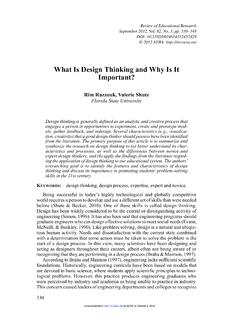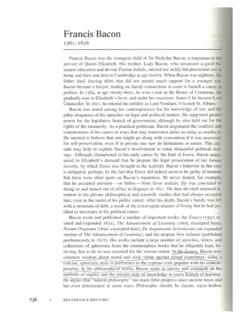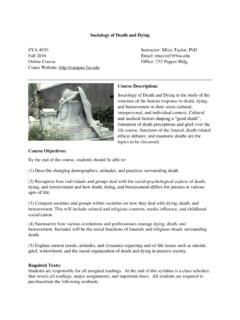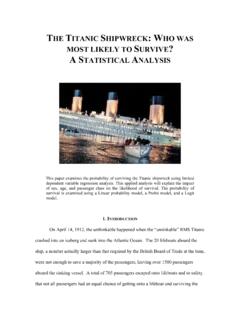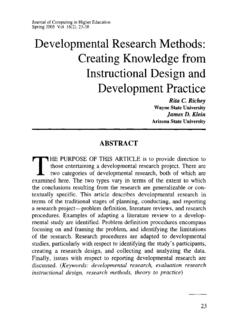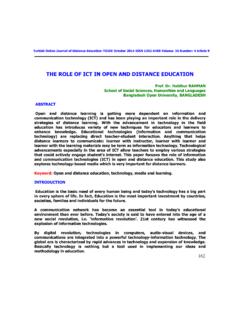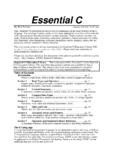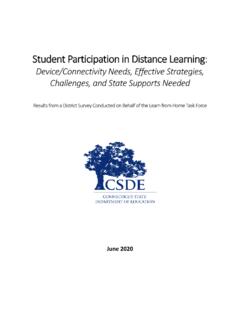Transcription of Theory and Distance Education
1 Theory and Distance EducationMost students and many teachers cringe at the thought of adiscussion of Theory . This need not be the case. This section isdesigned not to intimidate or to bore, but to inform. Theory isimportant to the study of Distance Education because it has adirect impact on the practice of the field. Traditionally, theoriesof Distance Education have come from sources external toAmerica. Recently the field in the United States has matured tothe point where indigenous definitions and theories havebegun to Need for TheoryAlthough forms of Distance Education have been in existencesince the 1840s and attempts at theoretical explanations of dis-tance Education had been undertaken by leading scholars inthe field, the need for a Theory base of Distance Education wasstill largely unfulfilled in the 1970s.
2 Holmberg (1986) statedthat further theoretical considerations would contribute resultsthat will give Distance educators a firmly based Theory , a touch-stone against which decisions can be made with confidence. In1985, Holmberg continued to recognize the need for theoreticalconsiderations:One consequence of such understanding and explanationwill be that hypotheses can be developed and submitted tofalsification attempts. This will lead to insights telling uswhat in Distance Education is to be expected under whatconditions and circumstances, thus paving the way for cor-roborated practical methodological application. (p. 3)Moore (1994) was concerned that the progress of Distance edu-cation would be hindered by the lack of attention to what hecalled the macro factors.
3 He indicated that in this area ofeducation there was a need to describe and define the field, to16 Distance Educationdiscriminate between the various components of the field, andto identify the critical elements of the various forms of learningand (1988) implied the continued need for a Theory of dis-tance Education when he lamented the lack of it:Lack of accepted Theory has weakened Distance Education :there has been a lack of identity, a sense of belonging to theperiphery, and the lack of a touchstone against which deci-sions on methods, on media, on financing, on student sup-port, when they have to be made, can be made withconfidence. (p.)
4 63)More recently, Keegan stated his ideas about what the theoryshould encompass: According to Keegan (1988), a firmly basedtheory of Distance Education will be one that can provide thetouchstone against which decisions political, financial, educa-tional, social when they have to be taken, can be taken withconfidence. This would replace the ad hoc response to a set ofconditions that arise in some crisis situation of problem solv-ing, which normally characterizes this field of a general sense, Theory is taken to mean a set of hypotheseslogically related to one another in explaining and predictingoccurrences. Holmberg (1985) stated thatthe aim of the theoretician is to find explanatory theories;that is to say, the theories that describe certain structuralproperties of the world, and which permit us to deduce,with the help of initial conditions, the effects to beexplained.
5 Theoretical, to bring explanation, on theother hand practical, to provide for application or techno-logy. (p. 5)Keegan added (1995):Atheory is something that eventually can be reduced to aphrase, a sentence, or a paragraph and which, while sub- Distance Education17suming all the practical research, gives the foundation onwhich the structures of need, purpose, and administrationcan be erected. (p. 20)In 1995 Holmberg gave a more specific definition of the con-cept of Theory . He stated that a Theory means a systematicordering of ideas about the phenomenon of our field of inquiryand an overarching logical structure of reasoned suppositionswhich can generate intersubjectively testable hypotheses.
6 (p. 4)Holmberg suggested that Distance Education has been charac-terized by a trial and error approach with little considerationbeing given to a theoretical basis for decision-making. He sug-gested that the theoretical underpinnings of Distance educationare fragile. Most efforts in this field have been practical ormechanical and have concentrated on the logistics of some, Distance Education represents a deviation from con-ventional Education . Holmberg claimed it was a distinct formof Education . Keegan (1986) concluded that Distance educationis a distinct field of Education , parallel to and a complement ofconventional Education . Shale (1988) countered that all of whatconstitutes the process of Education when teacher and studentare able to meet face-to-face also constitutes the process of edu-cation when the teacher and student are physically and Kahl (1983) compared and contrasted distanceeducation and face-to-face Education in terms of psychologicaldimensions and claimed neither set of principles emerged in apure form.
7 Peters (1988) strongly stated:Anyone professionally involved in Education is compelledto presume the existence of two forms of instruction whichare strictly separable: traditional face-to-face teaching basedon interpersonal communication and industrialized teach-ing, which is based on objectivized, rationalized technologi-cally-produced interaction. (p. 20)18 Distance EducationIn his landmark work, The Foundations of Distance Education ,Keegan (1986) classified theories of Distance Education intothree groups: Theories of independence and autonomy Theories of industrialization of teaching Theories of interaction and communicationAfourth category seeks an explanation of Distance Education ina synthesis of existing theories of communication and diffu-sion, as well as philosophies of of Independent Study Charles Wedemeyer (Simonson, 2003)For Wedemeyer, the essence of Distance Education was theindependence of the student.
8 This was reflected in his prefer-ence for the term independent studyfor Distance Education at thecollege or university level. Wedemeyer was critical of contem-porary patterns of higher Education . He believed that outdatedconcepts of learning and teaching were being employed andthat they failed to utilize modern technologies in ways thatcould alter the set forth a system with 10 characteristics emphasiz-ing learner independence and adoption of technology as a wayto implement that independence. According to Wedemeyer, thesystem should:1. Be capable of operation any place where there are stu-dents or even only one student whether or not there areteachers at the same place at the same time2.
9 Place greater responsibility for learning on the student3. Free faculty members from custodial-type duties so thatmore time can be given to truly educational tasksDistance Education194. Offer students and adults wider choices (more opportuni-ties) in courses, formats, and methodologies5. Use, as appropriate, all the teaching media and methodsthat have been proved effective6. Mix media and methods so that each subject or unit withina subject is taught in the best way known7. Cause the redesign and development of courses to fit intoan articulated media program 8. Preserve and enhance opportunities for adaptation to indi-vidual differences9.
10 Evaluate student achievement simply, not by raising barri-ers concerned with the place, rate, method, or sequence ofstudent study10. Permit students to start, stop, and learn at their own pacesWedemeyer proposed the separation of teaching from learningas a way of breaking Education s space-time barriers. He sug-gested six characteristics of independent study systems:1. The student and teacher are The normal processes of teaching and learning are carriedout in writing or through some other Teaching is Learning takes place through the student s Learning is made convenient for the student in his or herown The learner takes responsibility for the pace of his or herown progress, with freedom to start and stop at any EducationWedemeyer noted four elements of every teaching-learning sit-uation: a teacher, a learner or learners, a communications sys-tem or mode, and something to be taught or learned.
